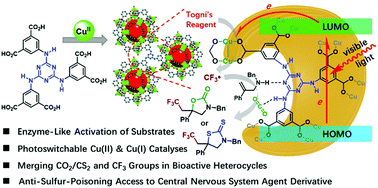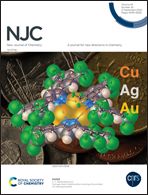Photoswitchable Cu(ii)/Cu(i) catalyses assisted by enzyme-like non-covalent interactions in Cu(ii)–melamine coordination polymers for installing CO2/CS2 and CF3 groups in heterocycles†
Abstract
Despite concerns over the environmental impact of isoelectronic CO2 and CS2, they remain useful C1 building blocks with industrial utility, and trifluoromethylation could enhance the lipophilicity and metabolic stability of agrochemicals and pharmaceuticals. Merging the CO2/CS2 moiety together with the CF3 group in one heterocyclic scaffold is both environmentally and pharmaceutically valuable, but it is still challenging for the homogeneous Cu-catalytic protocols to circumvent the issue of residual heavy metals, and the aggregation and sulfur-poisoning effect of Cu-species. In this report, a highly durable Cu(II)–melamine coordination polymer Cu–TDPAT, assembled from melamine-based ligand H6TDPAT and Cu(II) salt, was employed in the heterogeneous approach. The photoinduced electron transfer from the melamine-based ligand to the Cu(II) node of Cu–TDPAT and the ground-state back electron transfer enabled the controllable Cu(II)/Cu(I) switch. The enzyme-like non-covalent interactions not only enriched and activated CO2/CS2, the allylamine substrate, and Togni's reagent II, the CF3 radical precursor, but also drew close distances between them to facilitate the reaction. These advantages benefit from synergising the ground-state Cu(II)-triggered CO2 installation and the photogenerated Cu(I)-catalysed trifluoromethylation steps within the construction of biointeresting heterocycles in a sustainable and recyclable manner. In particular, this heterogeneous approach was applicable to the construction of a central nervous system agent derivative when CS2 was employed instead of CO2, showing the superior durability of Cu–TDPAT against sulfur-poisoning compared with its homogeneous counterpart.



 Please wait while we load your content...
Please wait while we load your content...